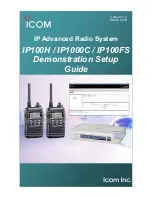
FRS420 – User Instruction Guide – Content Draft
TriSquare Communications
Draft for content only – customer to define layout and additional graphics
Page 1
Controls
1)
On/Off/Volume
control
2)
PTT
button
3)
Call/Menu
button
4)
Up
button
5)
Down
button
6)
Accessory
jack
LCD Display
1) Channel Number – displays the FRS channel
(1-14).
2) CTCSS Code Number – indicates the
current sub-audible code selected (0-38)
3) SCAN – displays when the scan feature is
active.
4) Vibrate Icon – displays when the vibrate
feature is selected.
FCC Information
•
This device complies with Part 15 of the
FCC Rules. Operation is subject to the
following two conditions: (1) This device
may not cause harmful interference, and (2)
this device must accept any interference
received, including interference that may
cause undesired operation.
•
Important: Changes or modifications to this
unit not expressly approved by Uniden could
void your authority to operate this unit.
Your radio is set up to transmit a regulated
signal on an assigned frequency. It is
against the law to alter the settings inside the
radio to exceed those limitations. Any
adjustments to your radio must be made by
qualified technicians.
•
To be safe and sure:
o
Never open your radio’s case
o
Never change or replace anything in your
radio except the batteries.
•
Your radio might cause TV or radio
interference even when it is operating
properly. To determine whether your radio
is causing the interference, turn it off. If the
interference goes away, your radio is
causing it. Try to eliminate the interference
by moving your radio away from the
receiver. If you cannot eliminate the
interference, the FCC requires that you stop
using the radio.
Safety Guidelines
•
Audio Accessories: Do not operate the
radio with audio accessories at high volume
levels. Hearing experts advise against
continuous high volume operation. If you
experience a ringing in your ears, reduce the
volume level or discontinue use. Always
make sure the radio is turned off before
plugging audio accessories into the
accessory jack.
•
Hazardous Environments: Do not operate
the radio in hazardous environments.
Explosion or fire may result. Do not operate
the radio near unshielded electrical blasting
caps. Under certain conditions, radios can
interfere with blasting operations and may
cause an explosion. Turn your radio OFF to
prevent accidental transmission when in a
blasting area or in areas posted: “Turn off
two-way radios.” Construction crews often
use remote control RF devices to set off
explosives.
•
Care and Safety: To clean the radio, use a
soft cloth dampened with water. Do not use
cleaners or solvents because they can harm
the body of the unit and leak inside, causing
permanent damage. Use a dry, lint-free
cloth to clean the battery contacts. Do not
submerge the unit in water. If the unit gets
wet, turn it off and remove the batteries
immediately. Dry the battery compartment
with a soft cloth to minimize potential water
damage. Leave the battery compartment
cover off overnight to ensure complete
drying. Do not use the radio until the unit is
completely dry.
picture
picture






















